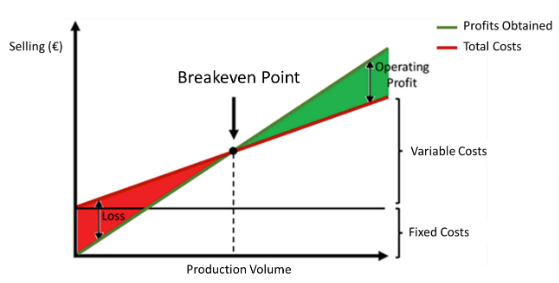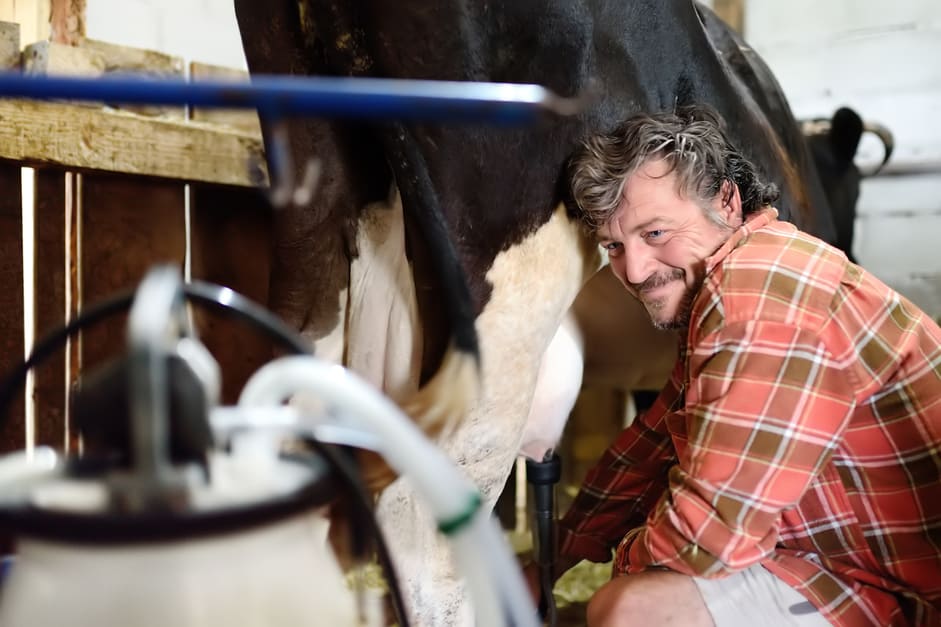As the dairy industry continues to evolve, dairy practitioners play a crucial role in helping dairy farmers optimise their operations for both efficiency and profitability. Evaluating various farm economic ratios can provide valuable insights into the performance of dairy farms. In this article, we will explore three key ones: breakeven point, feed efficiency, and income over feed cost (IOFC). It is important to note that conclusions should be taken by integrating the information provided by different ratios, rather than using just one or two.
Breakeven point
The breakeven point (Figure 1) is used in many financial and business areas, and it is defined by the level of output where cash outflow equals cash inflow. Hence, in dairy business it is defined by the exact amount of milk produced, at a given milk price, where total costs and revenue are the same. The breakeven point is therefore typically calculated by dividing the total costs by the milk price per unit. It is a useful tool to determine the minimum average milk yield, below which the farmer is losing money. It is worth pinpointing that breakeven point varies according to milk price and total costs (which in turn depend on many factors such as price fluctuation of energy, fertiliser and concentrate).

Figure 1 – Breakeven Point, indicated by the black dot, is the production volume where total costs are equal to profits obtained by product selling. Adapted from Ofileanu et al., 2014
Feed Efficiency
This ratio basically measures the amount of milk produced per unit of feed consumed. It is calculated by dividing the amount of solids-corrected milk produced per dry-matter of feed consumed.
It reveals how efficient the animals are at mobilising nutrients for milk production, and several factors may impact this ratio such as cattle comfort and health, stage of lactation, forage quality, feed bunk management, and unrestricted access to clean water. Hence, aiming at higher feed efficiency ratios means improving milk yield relatively to feed consumed. A lower number of animals may thus be used to achieve the same milk production, which enables the reduction of feed costs, natural resource use and carbon footprint.
Income Over Feed Costs
This ratio is calculated by subtracting feed costs from milk income. It indicates the margin left after covering feed expenses. The ratio is calculated according to the following formula:

As feed is the most significant cost in a dairy farm (›50%), IOFC is a valuable tool to monitor profit, as it accounts for the volatility of the feed markets. Monitoring IOFC regularly allows farmers to make decisions on their feeding strategies since higher milk yields do not necessarily mean higher profit margins if feed costs are high. As an example, Bach (2023) recently used this ratio to evaluate the advantages of feeding cows in groups according to their nutrient requirements. Based on the IOFC ratio, the author was able to conclude that moving cows according to milk production level did not result in economic advantages when the unit cost of nutrients is greater in the original than in the receiving ration. However, when the cost and nutrient difference between the diets offset potential losses in milk, forming groups according to production is advantageous.
Conclusion
Evaluating key farm economic ratios such as the breakeven point, feed efficiency, and IOFC is crucial for consultants, including dairy practitioners, when assisting dairy farmers in optimising their operations for efficiency and profitability. By understanding these metrics, they can provide evidence-based recommendations and help farmers make informed decisions.
References
Connor EE. Invited review: improving feed efficiency in dairy production: challenges and possibilities. Animal. 2015;9(3):395-408.
Ofileanu D, Bumbescu SS. The Analysis of the Factors Which Influence the Change of the Breakeven Point. Procedia Economics and Finance. 2014;16:356-67.
Buza MH, Holden LA, White RA, Ishler VA. Evaluating the effect of ration composition on income over feed cost and milk yield. J Dairy Sci. 2014;97(5):3073-80.
Bach A. Changes in milk production and estimated income over feed cost of group-housed dairy cows when moved between pens. J Dairy Sci. 2023 Jun;106(6):4108-4120. https://www.doi.org/10.3168/jds.2022-22875. Epub 2023 Apr 20. PMID: 37087302.
Chen Y, Hostens M, Nielen M, Ehrlich J, Steeneveld W. Herd level economic comparison between the shape of the lactation curve and 305 d milk production. Front Vet Sci. 2022 Sep 15;9:997962. https://www.doi.org/10.3389/fvets.2022.997962. PMID: 36187808; PMCID: PMC9521045.




Leave your comments here